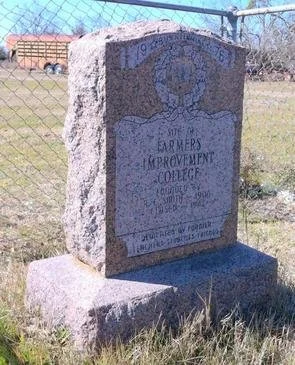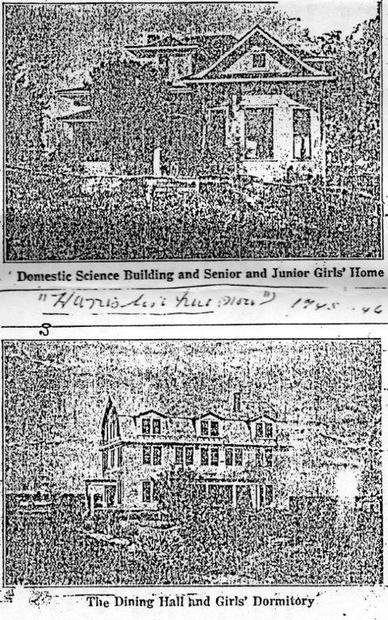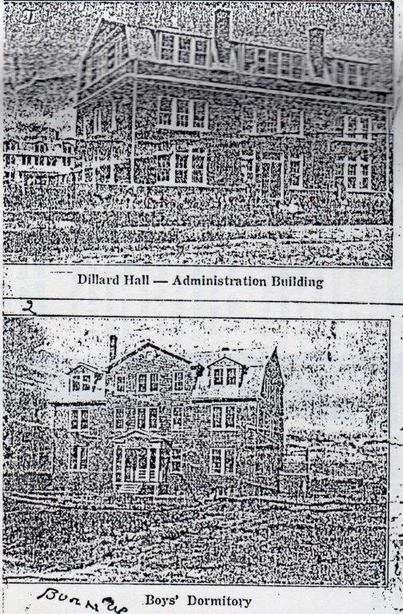Farmers’ Improvement School (F. I. S. College)
The Farmers' Home Improvement Society, a self-improvement society which provided various services to the black community in Texas, established a school in Fannin County near Ladonia in 1906. The school operated until 1947.
Very little remains of the college at its former site. The monument shown at the right was dedicated in 1976.
The article and newspaper photos are from the Dallas Journal, May 3, 1935.
The photos of FIS students below are courtesy the Texas Collection, Baylor University. Wonderful additional photos from the Texas Collection, Baylor University are on a separate page.
See additional photos from the Virginia Harris Hill Collection.
Read about F.I.S. Reunions.
School for Negroes Serves State Well at Wolf City
Institution Grows Under Direction of President R. L. Smith.
By Everett Woodson.
The Farmers' Improvement School, known to thousands of people of this section as F. I. S. College, has served the Negroes of North Texas for more than twenty years as an institution of higher learning. This year's term at the school comes to a close with the graduation exercises which will be held Thursday, May 16.
The school, an affiliated high school for Negroes, one of the few in the State, was founded by the man who is today president of the institution, R. L. Smith, who more than twenty years ago organized the school. Five years later Smith took charge of the school himself and has since directed the school.
Smith has been prominent as a leader of his race. Former editor and one time a banker, he represented his home, Colorado County in the Legislature of Texas, for four years, under the governorship of Culbertson. He inaugurated the colored division of the extension service and worked hard with admirable results during the World War, organizing Negroes throughout the State, instructing them about raising supplies to feed the starving millions of Europe.
Smith was organizer of the Farmers' Improvement Society, the object of which is to improve negro methods of farming and to educate the child of Negroes along proper lines. He is a graduate of Atlanta University, Atlanta, Ga., called the leading negro school of the South, and holds the B. A. degree. He is one of the vice presidents of the American Bible Society.
A garden, inferior to none in Texas, supplies much of the food consumed in the college; ields of corn make the bread supply plentiful and oats grow on the acres occupied by the school. A colt canters through the pasture, and, whether or not its name is Black Beauty, well might it be called by that name.
The school, possessing modern facilities and three large buildings housing the various activities of the school, as well as model homes of the girls and residences of the faculty members, presents an inspiring sight as Negro achievement.
A fine library at the school gives students an opportunity for intensive study on a wide variety of subjects, and a good chemical laboratory makes possible experiments in scientific branches of learning.
Most of the money to carry on the program at the school is earned from a ninety-acre farm, on which diversified farming is pursued on a large scale. Students at the school work the land. Many times a boy will follow the plow during one day and the next spend many hours in the classroom.
"The main purpose of the school is to demonstrate practically that farm life or farming is the best occupation for Negroes, young or old. My belief is that the average Negro farm life is more suitable, with minor exceptions, and it is this though that we are promoting in the school," Smith said with the earnestness of a zealot.
Though the efforts of the students, the school has acquired ninety acres of land and created four beautiful buildings, admirably suited to the purpose of the school. Without State aid of any kind, and through donations, principally from Negroes, and some from white friends, the school has continued. What one sees on visiting the place shows that one of the objects of the school is to make farm life appear attractive, because the plant is the essence of comfort and beauty, and is a combination of practical utility and culture. The school trains the Negro to keep his feet close to the soil.
The development of the school has been steady but slow, due to the fact that its income has been seriously impaired due to economic conditions.
Honey Grove Signal, August 10, 1906
Negro Agricultural School.
The negroes of North Texas are preparing to establish an agricultural and mechanical college about four miles west of Ladonia. They have purchased a tract of 58 acres of land and have paid for same. They have also had plans drawn for a main building to cost $3500 and will lay the cornerstone on the 23d of the present month.
In this good work the negroes have received much encouragement from the white people of Ladonia.
Honey Grove Signal, September 21, 1906
The colored people have located an agricultural and industrial college about midway between Ladonia and Wolfe City. The corner stone of the building was laid last Friday and was made a great occasion. Well known white men of Ladonia and Wolfe City and several well known colored orators delivered addresses.
Honey Grove Signal, November 16, 1906
The negro industrial school, situated between Ladonia and Wolfe City, is nearing completion. The buildings, according to the plans of the architects and contractors, will be ready for occupancy within three weeks. The site is on a commanding eminence in a seventy-five acre tract of land and is plainly visible from the Santa Fe railroad tracks.
The following is from From Tall Grass to High Cotton, published by the Wolfe City Chamber of Commerce, 1999
F. I. S. College
The Farmers' Improvement School, commonly known as F. I. S. College, flourished for almost forty years outside of Wolfe City in the early part of the twentieth century. Not really a college in the modern sense of the word, F. I. S. was an affiliated high school and trade institute for young blacks interested in agriculture.
The school was the dream of Mr. R. L. Smith, a prominent African American educator, legislator and businessman. Mr. Smith, who graduated from Atlanta College in Georgia and came to Texas in the 1880s, believed in the philosophy of self-help and solidarity as a way to economic freedom for the African American farmer. In 1890, to provide his ideas, he organized the Farmers' Home Improvement Society to encourage black farmers to a more independent life through home ownership, cooperative buying, cash purchases instead of credit buying, and raising much of their own food. The Farmers' Improvement Society spread throughout Texas, Oklahoma and Arkansas. By 1909 the society had a membership of 21,000.
Smith's belief in the value of education and the importance of agriculture to American Americans and the success of the Farmers' Home Improvement Society stimulated him to create F. I. S. in 1906. (At that time Northeast Texas had no institution for African Americans higher than elementary school except at Texarkana and Paris.)
The school, started with only a couple of thousand dollars of donations and twenty five acres of land located three miles southwest of Ladonia near the Hunt County line just south of the Santa Fe Railroad.
The key to the success of the institution in the first years of its history was the support of a group of progressive minded local African American farmers: Dennis Pollard, Gulford and Henry Dickerson, Barney Simmons, Brandon Pruitt, James L. Gilmore, At Crumby Albert Locke, Will Dickerson and other. Prominent whites in Ladonia and Wolfe City supported the institution with donations.
The first permanent building was erected in 1908 at a cost of $3800.00 money raised by R. L. Smith and his wife. From this modest start the physical plant of the school grew to four large veneer buildings, which included (1) Dillard Hall (Administration Building), (2) Boys Dormitory, (3) Domestic Science Bulding, and Senior and Junior Girls' Home, (4) and The Dining Hall and Girls Dormitory.
F.I. S. was a boarding school, with twelve grades from elementary through high school. For 1911, the tuition was $7.00 per month which included room and board. In addition students worked part time at the school to support themselves. Enrollment averaged about 90 students per term.
The institution operated on the principle that young people learn by doing.
Students and faculty divided their time between the practical chores of cultivating corn, oats, cotton, vegetables and orchard on the farm and absorbing the academic instruction. the school had a curriculum that included academic courses in liberal arts, sciences education, and agriculture. Retired school teacher Mrs. Olivia Gilmore Scales, whose father was Vice President of F. I. S., recalls that the school offered in the 1920s language arts, history, algebra, composition and Latin and practical hands-on courses in domestic science, teaching horticulture, floriculture, dairying, animal husbandry, poultry raising, and canning.
The school had cordial elations with the citizens and businesses of Wolfe City with Mr. Smith arranging concerts by the school's chorus in local white churches. The Wolfe City newspaper always wrote complimentary articles on the school and its educational endeavors.
During the 1930s possibly because of the Great Depression and changing ways of teaching, F. I. S. Gradually declined in popularity. Perhaps because of this and the ongoing financial exigencies of the institution, founder and president Mr. Smith induced the trustee of the school in 1940 to offer the land and buildings to the state for a four year college for African American youth similar to Prairie View College.
The Wolfe City Sun and leading white citizens of the area endorsed the idea but the Texas legislature did not respond.
Mr. Smith died in 1942. The school did not survive much beyond World War II, closing its doors at the of the 1946-47 academic year, a causality of the decline in the important of agriculture and the emergence of public high schools for African Americans.
Ad from the Sept. 21, 1921 Dallas Express






